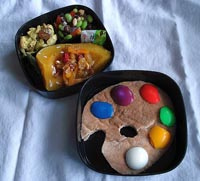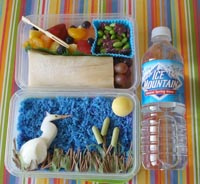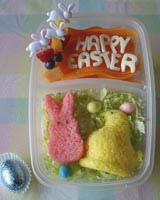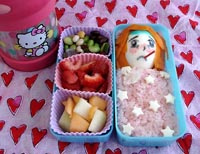Fun with egg whites
If your diet allows for use of hard-boiled eggs, they can be a lot of fun to work with. Hard-boiled egg whites are a wonderful source of protein and very versatile in terms of cutting and coloring. They pop up quite often in my bentos.
 Almost all of the blossoms in the garden bento I showed you earlier are egg white; they were cut with a set of tiny gum-paste cutters (available in cake decorating shops) and tinted with food coloring. For those of you curious about how so many blossoms stayed in place… that was some strategic anchoring, nestling each blossom between peapod leaves that were pressed into the rice at an angle. The bento held up very well — the flowers barely budged in transit.
Almost all of the blossoms in the garden bento I showed you earlier are egg white; they were cut with a set of tiny gum-paste cutters (available in cake decorating shops) and tinted with food coloring. For those of you curious about how so many blossoms stayed in place… that was some strategic anchoring, nestling each blossom between peapod leaves that were pressed into the rice at an angle. The bento held up very well — the flowers barely budged in transit.
You can use a store-bought egg/mozzarella slicer to produce slices of uniform thickness, but I prefer to go with a reliable paring knife. I usually cut the eggs lengthwise to get the longest strips. You can cut whatever shape you like, either by hand or with a cookie, fondant, or gum-paste cutter. You can work with the egg’s roundness to give a 3-D aspect to your shapes, which can be pretty cool (like the puddles of “paint” to the left). Experiment with thicknesses and the natural curve of the egg white by cutting a few practice shapes. You’ll find that if you cut too near a curve, the shape will crack. If you go on to dye a cracked piece, the crack will really stand out, so it’s worthwhile to do a “practice egg” to get a feel for cutting.
 I have a lot of silicone baking cups that are indispensable for coloring small batches of egg white and veggies. The best thing about these is that they can be pinched closed as the dye-water is drained to avoid the frustrating loss of teeny little pieces. Just add your cutouts to a little bit of cool water and a few drops of coloring, then stash them on a plate in the fridge. Egg white takes on most colors quickly and you’ll usually achieve the desired shade in a few minutes. The shapes can be rinsed and drained right in the cup. After the rinse water runs clear (ensuring that the piece won’t stain whatever’s underneath), blot the cutout gently with a paper towel. At that point, it’s ready to place on the bento.
I have a lot of silicone baking cups that are indispensable for coloring small batches of egg white and veggies. The best thing about these is that they can be pinched closed as the dye-water is drained to avoid the frustrating loss of teeny little pieces. Just add your cutouts to a little bit of cool water and a few drops of coloring, then stash them on a plate in the fridge. Egg white takes on most colors quickly and you’ll usually achieve the desired shade in a few minutes. The shapes can be rinsed and drained right in the cup. After the rinse water runs clear (ensuring that the piece won’t stain whatever’s underneath), blot the cutout gently with a paper towel. At that point, it’s ready to place on the bento.
 This white heron was made with a single hard-boiled egg. I cut the egg in half lengthwise and removed the yolk (which went on to become that moon in the top left corner). I cut an S shape from one half of the white, working with the natural curve, and layered it with the other half, cut in the shape of a wing. A leftover shred served as the crest; then I added a carrot beak and a single black sesame seed (held on with a dot of mustard) as the eye. I was really pleased with how he turned out.
This white heron was made with a single hard-boiled egg. I cut the egg in half lengthwise and removed the yolk (which went on to become that moon in the top left corner). I cut an S shape from one half of the white, working with the natural curve, and layered it with the other half, cut in the shape of a wing. A leftover shred served as the crest; then I added a carrot beak and a single black sesame seed (held on with a dot of mustard) as the eye. I was really pleased with how he turned out. ![]()
 It’s also easy and fun to spell out various messages in egg-white letters. Alphabet-shaped fondant cutters are widely available in the cake-decorating section of craft stores; all you have to do is be careful with them. A bamboo cocktail fork, like the ones pictured in the silicone cups of dye, are excellent for nudging stubborn egg pieces from cutters. The ends are blunt, so they don’t pierce the surface as a toothpick might.
It’s also easy and fun to spell out various messages in egg-white letters. Alphabet-shaped fondant cutters are widely available in the cake-decorating section of craft stores; all you have to do is be careful with them. A bamboo cocktail fork, like the ones pictured in the silicone cups of dye, are excellent for nudging stubborn egg pieces from cutters. The ends are blunt, so they don’t pierce the surface as a toothpick might.
I do have one word of caution about the use of metal fondant-cutters: most are dishwasher-safe, but are quick to rust if you accidentally leave them in for more than one cycle. They’re so small, with little nooks and crannies that are so good at catching moisture and food bits, that it’s best to keep track of them and get them handwashed quickly, then dry them thoroughly after use. It can be a pain sometimes, but it’s better than dealing with nasty, rusty cutters.
 You can also leave a shelled, hard-boiled egg whole and paint a face on it, as I did here. The face was drawn with black food color and a flexible plastic toothpick (more on those techniques in another post). I added red cross-hatching for fevered cheeks and pressed a toothpick in at an angle for the thermometer (removed before eating, of course). The egg is held in place by the carrot-shred hair and the ume-rice coverlet. A second hard-boiled egg was turned into hands and star decoration. It might be fun to make an egg family, with chicken-egg adults and quail-egg kids. I’d do it myself if there were any fresh quail eggs to be had around here
You can also leave a shelled, hard-boiled egg whole and paint a face on it, as I did here. The face was drawn with black food color and a flexible plastic toothpick (more on those techniques in another post). I added red cross-hatching for fevered cheeks and pressed a toothpick in at an angle for the thermometer (removed before eating, of course). The egg is held in place by the carrot-shred hair and the ume-rice coverlet. A second hard-boiled egg was turned into hands and star decoration. It might be fun to make an egg family, with chicken-egg adults and quail-egg kids. I’d do it myself if there were any fresh quail eggs to be had around here ![]()
All it takes is a couple of hard-boiled eggs and a little creativity to add a fun, high-protein kick to your lunch. Try it out!
FURTHER READING:




